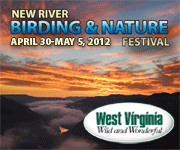That winter was snowy for Richmond, Virginia. Big blankets of heavy wet snow made a mess of the streets and the southern drivers, not to mention their cars. I loved nothing more than awakening on a school day to see that special snow light peeping under the shade, the white, pure light that sets a child's heart singing with the hope of sledding instead of homework.
On one such morning, I tore downstairs to find my mother and father craning their necks out the kitchen window at a flock of strange birds in our sweet gum tree. They were mustard yellow, black and white, though some were gray, with pied wings. A ringing cleer! call punched the stillness and snow quiet. Several sat on the simple table feeder that my father had welded from a pipe and a steel plate. They had already cleaned up the sunflower seed there and seemed to be looking for more. "Giant goldfinches!" I yelled as I ran for my well-worn National Geographic Song and Garden Birds of North America.
They were evening grosbeaks, of course, and there were sixty of them, a flock such as I've never had since at any feeder. They showed up around Christmas and stayed into spring. We began buying striped sunflower seed in fifty-pound bags. This was a pretty extravagant purchase in 1967. I got up early every morning to put seed out for the flock, which my father referred to as "Julie's chickens." We loved to watch them squabble over the food, and we loved the way they looked, hanging in the trees like big ornaments. At about the same time, my father, who always spent his free time in his basement workshop, became secretive and wouldn't let me watch him work as he always had. I suspected he was making something for me.
On Christmas morning, I awoke to the familiar sound of grosbeaks fighting and feeding, but it was unusually loud. On the dining room windowsill was a feeder, the grandest one ever made, with a long dowel perch and a Plexiglas top to keep the seed dry, with drainage holes and a new coat of gray paint. It was three feet long, and the grosbeaks crammed into it by the dozen to wade in sunflower seeds. It was my Christmas present, and I can't remember one before or since that has thrilled me as much--not a bicycle or a guitar, a book or a trip.
My father was to make many more feeders, always from found materials--hubcaps and plastic pipes, odds and ends from the warehouse of the pipeline company where he worked. The most elegant piece he produced was a birdbath constructed of a steel pipe welded to an old harrowing disc. Its edges are gently scalloped from wear, and the iron is pitted from decades of immersion. It is the perfect depth for a goldfinch to wade into, the perfect width for a whole family of bluebirds to share. Dad painted it a creamy white to look like a destroying angel mushroom, and it does. He showed me how to scrub it out with a lump of sod, soil still attached, scouring away the brown algae. "Dirt cleans pretty well," he used to say. Your mother wouldn't agree, but it does." (He pronounced it "mither.")
The windowsill feeder finally rotted apart in 1991, and my father died in 1994. When we cleaned out the big house, I got a checkerboard he'd made, a table he'd constructed from an iron sewing machine stand and a plank of fine cherry, an ancient Scots rocker he'd refinished, and the destroying angel mushroom birdbath. It stands in my front yard, surrounded by rhubarb and flowers, and I still clean it with a lump of sod.
I have a picture of my dad sitting with me on the living room carpet, looking through a great sheaf of Audubon prints he'd gotten for me. He's in an old short-sleeved shirt, the front smeared with grease and oil, varnish and paint from his projects. I'm in heavy black Buddy holly glasses and short hair, a good look for a hardened tomboy. It's the only picture I have of just us two together, but it speaks volumes about our relationship. Youngest of the five children, I latched onto my dad the hardest, followed him around the yard as he gardened, learning his craft seed by seed, weed by weed. I feigned an interest in antique gasoline engines because he would take me out with him, looking for them on long drives through the Virginia countryside. Where there were iron wheels peeking from the weeds, there were bound to be birds, and I wore his old German binoculars' pebbled finish smooth watching them. We became good at evaluating tumbledown sheds for both their machinery and their barn swallow potential.
I am writing this (October 1996) with my three-month old daughter lounging on a pillow on my lap, her legs hanging off one side as she nurses. She will never know her grandfather, never feel him squeeze her foot, hear him say, "This baby likes to have her foot squeezed," something he claimed about every baby. He had a soft spot for little girls, as he had for me. I realize only now, on becoming a parent, that all the things a child becomes are outgrowths of who her parents are and what they do. I am grateful for all the things he was--farmer, gardener, bird watcher, handyman, teacher, inventor, teller of stories.







































Sunday, August 12, 2012
12 comments